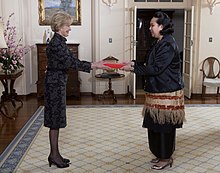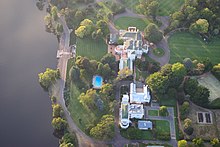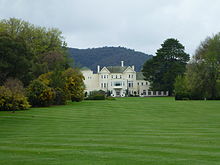
William Philip Sidney, 1st Viscount De L'Isle,, known as Lord De L'Isle and Dudley between 1945 and 1956, was a British Army officer, politician and Victoria Cross recipient who served as the 15th Governor-General of Australia, in office from 1961 to 1965. He was the last non-Australian to hold the position.

Admiralty House is the Sydney official residence of the governor-general of Australia. It is located in the suburb of Kirribilli, on the northern foreshore of Sydney Harbour. This large Victorian Regency and Italianate sandstone manor, completed in stages based on designs by James Barnet and Walter Liberty Vernon, occupies the tip of Kirribilli Point. Once known as "Wotonga", it has commanding views across Sydney Harbour to the Sydney Harbour Bridge and the Sydney Opera House.
The history of Canberra details the development of the city of Canberra from the time before European settlement to the city's planning by the Chicago architect Walter Burley Griffin in collaboration with Marion Mahony Griffin, and its subsequent development to the present day.
Alfred Ludlam was a leading New Zealand politician, horticulturist and farmer who owned land at Wellington and in the Hutt Valley. A member of three of New Zealand's four earliest parliaments, he was also a philanthropist and a founder of Wellington's Botanic Garden.

Yarralumla is a large inner south suburb of Canberra, the capital city of Australia. Located approximately 3.5 km (2.2 mi) south-west of the city, Yarralumla extends along the south-west bank of Lake Burley Griffin from Scrivener Dam to Commonwealth Avenue.
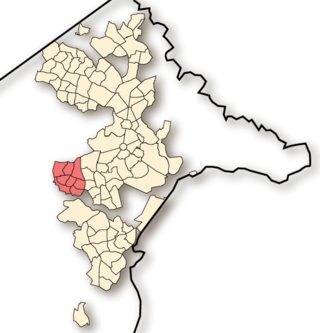
Weston Creek is a district in the Australian Capital Territory in Australia. The district is subdivided into divisions (suburbs), sections and blocks. The district comprises eight residential suburbs, situated to the west of the Woden Valley district and approximately 13 kilometres (8.1 mi) southwest of the Canberra City centre. Situated adjacent to the district was the large Stromlo Forest pine plantation until the forest was destroyed by bushfires in 2001 and 2003.

Old Parliament House, formerly known as the Provisional Parliament House, was the seat of the Parliament of Australia from 1927 to 1988. The building began operation on 9 May 1927 after Parliament's relocation from Melbourne to the new capital, Canberra. In 1988, the Commonwealth Parliament transferred to the new Parliament House on Capital Hill. It also serves as a venue for temporary exhibitions, lectures and concerts. Old Parliament House is, looking across Lake Burley Griffin, situated in front of Parliament House and in line with the Australian War Memorial.

Government House is the official residence of the Governor of Victoria, currently Margaret Gardner. It is located in Kings Domain, Melbourne, next to the Royal Botanic Gardens.

Government House is a heritage-listed mansion at 170 Fernberg Road, Paddington, Brisbane, Queensland, Australia. It is the official residence of the governor of Queensland, the representative of the Australian monarch in Queensland. It was originally designed by Benjamin Backhouse and built 1865, but has been subsequently extended and refurbished. It is also known as Fernberg. It was added to the Queensland Heritage Register on 21 October 1992.

St John the Baptist Church is an Australian Anglican church in the Canberra suburb of Reid in the Australian Capital Territory. The church is located at the corner of Anzac Parade and Constitution Avenue, adjacent to the Parliamentary Triangle, and is the oldest surviving public building within Canberra's inner city and the oldest church in the Australian Capital Territory. It has been described as a "sanctuary in the city", remaining a small English village-style church even as Australia's capital grew around it. Over time, it became a focal point for Australia's governors-general, politicians, public servants and military leaders, and has hosted royalty on numerous occasions.
The following lists events that happened during 1937 in Australia.
The history of the Australian Capital Territory (ACT) as a separate administrative division began in 1911, when it was transferred from New South Wales to the Australian federal government. The territory contains Australia's capital city Canberra and various smaller settlements. Until 1989, it also administered the Jervis Bay Territory, a small coastal region.

Sir Terence Aubrey Murray was an Irish-Australian pastoralist, parliamentarian and knight of the realm. He had the double distinction of being, at separate times, both the Speaker of the New South Wales Legislative Assembly and the President of the New South Wales Legislative Council. From 1837 to 1859 he owned the Yarralumla estate, which now serves as the official Canberra residence of the Governor-General of Australia.
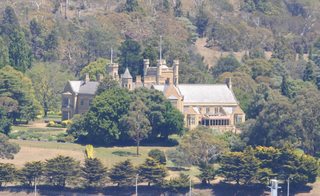
Government House, Hobart, is the home and official residence of the governor of Tasmania, Australia. The palatial house is located on Lower Domain Road in the Queens Domain, near the Royal Tasmanian Botanical Gardens. There have been three Government Houses, all in Hobart.

Zara Hore-Ruthven, Countess of Gowrie was the Anglo-Irish wife of the 1st Earl of Gowrie, Governor of South Australia 1928–34, Governor of New South Wales 1935–36 and the longest serving Governor-General of Australia 1936–44. She was renowned for her work in promoting the welfare of children in Australia, and the Lady Gowrie Child Centres were named in her honour.

Royal Canberra Hospital was the first hospital in Canberra, the capital of Australia. It opened in 1914 on the Acton Peninsula, as the Canberra Community Hospital. It grew to become the major hospital in Canberra before being closed in 1991 and later demolished in 1997.

Colonel John George Nathaniel Gibbes was a British army officer who emigrated to Australia in 1834 on his appointment as Collector of Customs for the Colony of New South Wales, an appointment which gave him a seat on the New South Wales Legislative Council and which he held for 25 years.
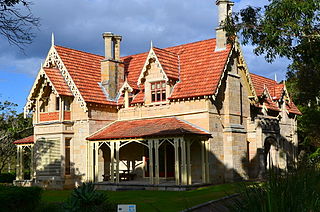
Greycliffe House is an historic, two-storey residential dwelling situated in the Sydney suburb of Vaucluse, New South Wales, Australia. Completed in c. 1852 in the Victorian Rustic Gothic style, Greycliffe is listed on the Australian Register of the National Estate and on the Municipality of Woollahra local government heritage list.

The Yarralumla Woolshed in the Australian Capital Territory is a building of historical significance and is listed on the Act Heritage Register. It is a symbol of Canberra's growth from pastoral town to major city. The shed was built in 1904 by Frederick Campbell who at that time owned Yarralumla Homestead which is now Government House. Today the woolshed is owned by the ACT Government and is an important community social centre and a venue for folk concerts, bush dances and is available for weddings.

Wattle Queen or the Wattle Painting is the official Australian portrait of Elizabeth II, who reigned as Queen of Australia from 1952 to 2022. Painted in 1954 by Sir William Dargie, the portrait became one of the most recognisable and best-known examples of 20th century Australian portraiture.






